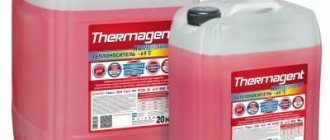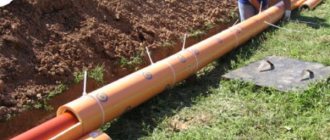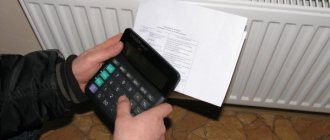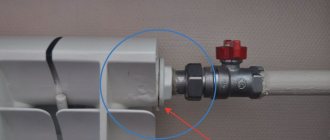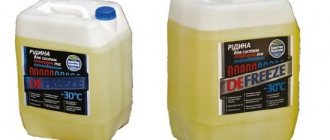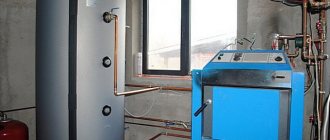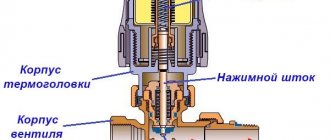In what cases is the coolant volume calculated?
The liquid in the water circuit of the heating system performs the most important function - it is a heat carrier. Many elements of the heating system are selected relative to the volume of coolant being distilled. Therefore, preliminary calculations will allow you to complete the heat supply most efficiently. It is easy to calculate the total volume of coolant, given that the amount of liquid in radiators is 10-12 percent of the total amount of liquid being distilled.
Calculation of water in the heating system must be done in the following cases:
- before installing heating, determine the amount of coolant that will be distilled by a boiler of a certain power;
- when non-freezing liquid is poured into the system, it is necessary to maintain a certain proportion in relation to the entire distilled liquid;
- the size of the expansion tank depends on the amount of coolant;
- you need to know the required volume of water in the heating system of country or private houses where the water supply is not centralized.
In addition, in order to properly mount the batteries on the wall, you need to know their weight. For example, just one section of a cast iron radiator, already heavy, holds 1.5 liters of liquid. That is, the seven-section cast-iron battery becomes more than ten kilograms heavier when the system starts.
Eventually
As you can see, calculating the heating capacity comes down to calculating the total value of the four above elements.
Not everyone can determine the required capacity of the working fluid in a system with mathematical accuracy. Therefore, not wanting to perform the calculation, some users act as follows. To begin with, fill the system to approximately 90%, after which the functionality is checked. Next, the accumulated air is released and filling continues.
During operation of the heating system, a natural decline in the coolant level occurs as a result of convection processes. In this case, there is a loss of power and productivity of the boiler. This implies the need to have a reserve tank with working fluid, from where it will be possible to monitor the loss of coolant and, if necessary, replenish it.
What situations can be avoided if you correctly calculate the volume of coolant
Many people install a heating system, relying on the advice of experts, friends or their own intuition. Choose a more powerful boiler and increase the number of radiator sections “just in case.” But the result is the opposite picture: instead of the expected heat, the batteries do not warm up evenly, the boiler “winds” fuel idle.
You can avoid the following unpleasant situations if you know how to calculate the amount of water in the heating system:
- uneven heating of the water circuit in the rooms;
- increased fuel consumption;
- emergency situations (broken connections, leaks in radiators).
All these “surprises” are quite predictable if the volume of coolant is incorrectly calculated.
Attention! Antifreeze should not be used in a heating system that uses galvanized pipes or other elements.
Is it possible to turn on a gas boiler if the water is turned off?
Is it possible to turn on gas heating if the water is turned off? If the water in the boiler is at a sufficient level, then of course the heating can be turned on. And if water is not provided for a long time, and water needs to be added to the boiler, then in this case it is better to turn off the boiler.
Interesting materials:
How to dye your head with henna? How to paint the matrix correctly? How to properly attach thermal insulation? How to properly attach gutters? How to spin a spiked hoop correctly? How to bathe a Chihuahua correctly? How to bathe a Yorkie correctly? How to eat dates correctly? How to eat flax correctly? How to eat bran correctly?
What can you take from the documentation?
Technical data sheets for devices, if available, will help you find out how much water will circulate in the heating radiator and boiler during operation of the heating system.
If you need to choose a radiator based on coolant volume, you can compare different options:
- aluminum and bimetallic with a height of 300 and 500 mm hold 0.3 and 0.39 l/m, respectively;
- cast iron MS-140 with a height of 300 and 500 mm. holds 3 and 4 l/m respectively;
- an imported cast iron radiator with a height of 300 and 500 mm will include 0.5 and 0.6 l/m.
Thus, the volume of a bimetallic radiator is the same as that of an aluminum radiator.
Another “cheat sheet” will help when selecting cast iron radiators of different models (the amount of coolant per section is indicated):
- MS 140 – 1.11–1.45 l
- World Cup 1 – 0.66–0.9 l s;
- World Cup 2 – 0.7–0.95 l;
- World Cup 3 – 0.155–0.246 l;
As for pipes, the calculations are as follows.
Based on the internal diameter of the pipes, in the documentation you can find out the amount of liquid they contain per linear meter:
- 13.2 mm - 0.137 l;
- 16.4 mm - 0.216 l;
- 21.2 mm - 0.353 l;
- 26.6 mm - 0.556 l;
- 42 mm - 0.139 l;
- 50 mm - 0.876 l.
The calculations are simple. So, for example, a 5-meter pipe with an internal diameter of 50 mm will hold 4.4 liters of water: 5x0.876 = 4.4
Attention! If you compare how many liters of water are in heating radiators of different models, you can choose the appropriate option that matches the power of the boiler.
How many liters of water are in 1 meter 16 pipes?
Internal volume of a linear meter of pipe in liters - table. Weight of water in the pipeline.
| Inner diameter, mm | Internal volume 1 m of pipe, liters = mass of water in 1 m, kg | Internal volume 10 m of pipe, liters = mass of water in 10 m, kg |
| 15 | 0,1767 | 1,7671 |
| 16 | 0,2011 | 2,0106 |
| 17 | 0,2270 | 2,2698 |
| 18 | 0,2545 | 2,5447 |
How to calculate the amount of coolant in radiators yourself
Sometimes you have to face a situation where it is impossible to determine whether radiators belong to a certain model. Documents for radiators may be lost, the model name is not visible. There is an easy way to find out how many liters are in a heating radiator without resorting to documentation or tables from the Internet.
Proceed as follows:
- close one side of the radiator with a plug;
- pour liquid to the top;
- pour the liquid into a measuring container.
Attention! There are two options for calculating the volume of water in a heating radiator: immediately note the amount of liquid poured in, or after draining it.
In this simple way you can calculate the amount of liquid that enters a radiator of any complexity or model.
Coolant flow
Coolant flow is calculated using the formula:
where Q is the total power of the heating system, kW; taken from the calculation of heat loss of the building
Cp—specific heat capacity of water, kJ/(kg*deg.C); for simplified calculations we take it equal to 4.19 kJ/(kg*deg.C)
Coolant flow calculator (water only)
In the same way, you can calculate the coolant flow on any section of the pipe. The sections are selected so that the water velocity in the pipe is the same. Thus, the division into sections occurs up to the tee, or before the reduction. It is necessary to sum up the power of all radiators to which the coolant flows through each section of the pipe. Then substitute the value into the formula above. These calculations must be made for the pipes in front of each radiator.
Critical stage: calculating the capacity of the expansion tank
In order to have a clear idea of the displacement of the entire heating system, you need to know how much water is placed in the boiler heat exchanger.
You can take averages. So, on average, a wall-mounted heating boiler contains 3-6 liters of water, while a floor or parapet boiler contains 10-30 liters.
Now you can calculate the capacity of the expansion tank, which performs an important function. It compensates for the excess pressure that occurs when the coolant expands when heated.
Depending on the type of heating system, tanks are:
- closed;
- open.
For small rooms, the open type is suitable, but in large two-story cottages, closed expansion joints (membrane) are increasingly being installed.
If the tank capacity is smaller than required, the valve will release pressure too often. In this case, you have to change it, or install an additional tank in parallel.
For the formula for calculating the capacity of the expansion tank, the following indicators are needed:
- V(c) is the volume of coolant in the system;
- K is the coefficient of water expansion (the value is taken as 1.04, based on the water expansion rate of 4%);
- D is the expansion efficiency of the tank, which is calculated by the formula: (Pmax – Pb)/(Pmax+1)=D, where Pmax is the maximum permissible pressure in the system, and Pb is the pre-pumping pressure of the compensator air chamber (parameters are indicated in the documentation for the tank );
- V(b) - expansion tank capacity.
So, (V(c) x K)/D = V(b)
How to calculate the power of a solid fuel boiler for a private home?
In order to calculate how much power a gas, solid fuel or electric boiler needs, the general formula is used: W cat. = (S*Wsp):10. For example, the area of the room prepared for heating is 100 m2, while the specific power for Ukraine is on average 1 kW.
Interesting materials:
How to download Libre Office? How to upload a mod to the workshop? How to upload videos to Yandex Disk? How to thicken coconut cream? How to thicken a thin sauce? How to access the site from a different IP address? How to enter Windows 10 safe mode on a Lenovo laptop? How to access the browser on iPhone? How to log into another Google account? How to enter the wheel of fortune in avatar?
Circulation pump calculation
Selection and calculation of the pump consists of finding out the pressure loss of the coolant flowing throughout the entire pipeline network. The result will be a figure showing how much pressure the circulation pump should develop in order to “push” water through the system. This pressure is calculated using the formula:
P = Rl + Z, where:
- P – pressure loss in the pipeline network, Pa;
- R – specific friction resistance, Pa/m;
- l – pipe length in one section, m;
- Z – pressure loss in local resistances, Pa.
Note. Two-pipe and one-pipe heating systems are calculated in the same way, according to the length of the pipe in all branches, and in the first case, the forward and return lines.
This calculation is quite cumbersome and complex, while the value of Rl for each section can be easily found using the same Shevelev tables. In the example, the blue circle marks the values of 1000i in each section; it only needs to be recalculated along the length of the pipe. Let's take the first section from the example, its length is 5 m. Then the friction resistance will be:
Rl = 26.6 / 1000 x 5 = 0.13 Bar.
We also calculate all sections of the associated heating system, and then summarize the results. It remains to find out the value of Z, the pressure drop in local resistances. For the boiler and radiators, these numbers are indicated in the product passport. For all other resistances, we recommend taking 20% of the total friction losses Rl and summing all these indicators. We multiply the resulting value by a safety factor of 1.3, this will be the required pump pressure.
You should know that pump performance is not the capacity of the heating system, but the total water flow through all branches and risers. An example of its calculation is presented in the previous section, but to select a pumping unit, you also need to provide a reserve of at least 20%.

